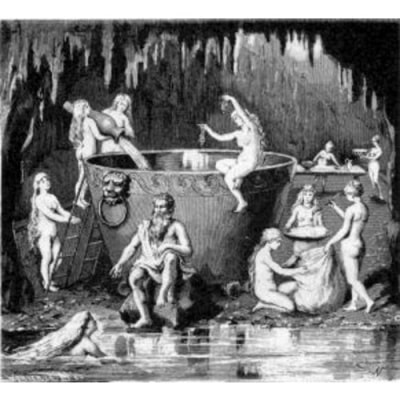Whenever you go out on the ocean, you are in the realm of Aegir, the jötun ruler of the sea. This powerful figure, known to be both generous and fearsome, is the husband of the intimidating sea-goddess Ran. A popular host for the gods’ lavish feasts, Aegir is a friend to the gods.
In this post, I will go through Aegir’s powers, role and his family. While not playing an integral part in any of the old stories, he is often involved. Interestingly, he might also be Heimdall’s grandfather, which I’ll get into shortly.
Aegir name and etymology
Ægir, also known as Hlér or Gymir, is a jötunn and the personification of the sea in Norse mythology. His name in Old Norse, “sea,” is reflected in various ways. Two examples are the island Læsø (Old Norse Hléysey, meaning “Hlér’s island”) and possibly Lejre in Denmark.
In the “Skáldskaparmál” of the Prose Edda, among several kennings, he is referred to as the “ale brewer of the gods.” Ægir’s influence has even extended into modern popular culture, as the fascination with Norse mythology continues to grow.
Etymology
The Old Norse name Ægir, meaning ‘sea,’ may originate from a Proto-Germanic form *āgwi-jaz (‘that of the river/water’), which is derived from the stem *ahwō- (‘river’). However, the connection between Proto-Germanic *ahwō- and Old Norse Ægir remains uncertain, and it could be a loanword from a non-Indo-European language.
In skaldic poetry, the name Ægir is synonymous with ‘sea’ and serves as a base word for various kennings. For example, a ship is referred to as “Ægir’s horse” and the waves are called the “daughters of Ægir.” Both Hversu Noregr byggðist (How Norway Was Settled) and Skáldskaparmál (The Language of Poetry) equate Ægir with the sea-jötunn Hlér, who lives on Hlésey (‘Hlér island’, modern Læsø).
The meaning of the Old Norse name Gymir remains unclear. Proposed translations include ‘the earthly’ (from Old Norse gumi), ‘the wintry one’ (from gemla), or ‘the protector’ and ‘the engulfer’ (from geyma). The relationship between Ægir, Hlér, and Gymir and the interpretation of their names continue to be subjects of scholarly debate and analysis.
Is Aegir a Giant or a God?
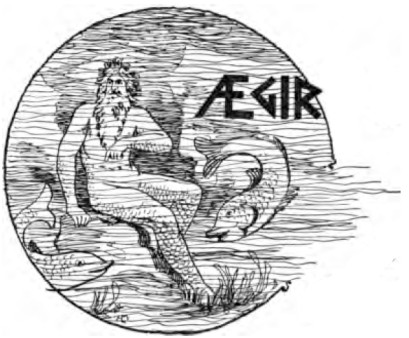
Though Aegir often rubs shoulders with the gods, he is not one of them. Rather, he belongs to the ancient race of the Jötnar. These towering beings, often associated with chaos and destruction, walk a fine line between friend and foe to the gods.
The giants’ role in Norse mythology is complex, as they are both allies, partners and adversaries to the gods. There are actually many gods that are half-Jötun, and there are others that have taken a Jötun as a wife.
Aegir’s unique position among them is a testament to the intricate relationships that exist within the Norse pantheon. As we explore Aegir’s story, we’ll see how he navigates these relationships while maintaining his status as a powerful and respected figure.
Origin and lineage of Aegir
Delving into Aegir’s past, we discover his roots in the realm of Jotunheim, the land of giants. Born to the jötun Fornjót, Aegir is a sibling to Logi, the embodiment of fire, and Kári, the spirit of the wind. Their elemental nature makes them a formidable trio, shaping the very world around them. According to the “Orkneyinga Saga,” Fornjót and his sons were kings of the north, ruling over vast lands and seas.
The family’s elemental powers were deeply rooted in their lineage, with each sibling commanding a specific aspect of nature. Aegir, as the ruler of the sea, held sway over the waters and all that dwelled within. So, while they are not gods in their own rights, they do rule over their own dominions.
Description of Aegir
As the waves crash upon the shore, I imagine Aegir rising from the depths. His appearance is a reflection of his domain – a mighty giant, his hair and beard composed of seaweed and foam, with eyes that mirror the ever-changing hues of the ocean. Aegir’s physical description, though not explicitly detailed in the Eddas, can be inferred from the various references to his connection with the sea and its inhabitants.
In some accounts, Aegir is depicted with a trident or a fishing spear, symbolizing his mastery over the watery realms. Others describe him with a horn overflowing with ale, a nod to his role as a generous host to the gods. Considering his role and description it is easy to compare him with the Olympian god Poseidon from Greek mythology.
What are Aegir’s powers and abilities?
As the ruler of the sea, Aegir’s powers are vast and formidable. With a mere flick of his hand, he can summon storms and conjure towering waves that crash upon the shore. In the “Skáldskaparmál,” a part of the Prose Edda, Aegir’s control over the sea is showcased as he is described as “the one who stills the waves.” This ability to command the ocean’s fury and calm made him both revered and feared by those who ventured out on the waters.
Aegir’s control over the seas was not just limited to storms and waves; he also held dominion over the sea creatures that inhabited its depths. Sailors and fishermen would look to him for a bountiful catch and safe passage through treacherous waters, understanding that his power could mean the difference between life and death. As we continue to explore Aegir’s world, we will see how his authority over the seas influenced the lives of those who lived in the Viking Age.
Brewing and hospitality
Aegir was not only a master of the seas but also a skilled brewer and gracious host. In the poem “Hymiskviða” from the Poetic Edda, the setup for the story is a planned feast at Aegirs. However, not having a cauldron large enough to brew all the mead they needed, Thor and Tyr go on an adventure in Jotunheim.
This reputation for hospitality extended beyond his brewing abilities. Aegir’s feasts were known to be grand and sumptuous, offering the gods a chance to gather, celebrate, and enjoy one another’s company. His underwater hall, a marvelous construction at the bottom of the ocean, served as the venue for these elaborate events. The stories of Aegir’s feasts and his brewing prowess highlight his significance as a connector of worlds, both terrestrial and divine.
Play Jötunn Quiz
Do you want to learn more about the magical and powerful Jötunn? Then test your knowledge with this fun quiz game!
Don’t forget to play our other games as well!
Who is Aegir’s wife Ran?
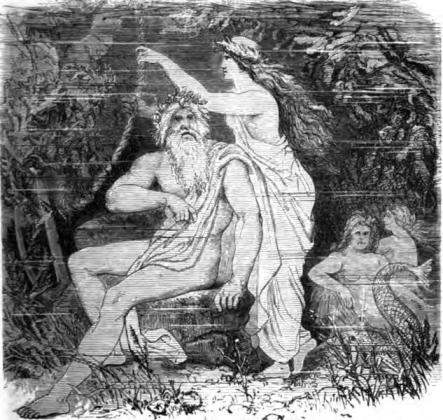
Aegir’s wife, the sea goddess Ran, is a vital figure in his life and in Norse mythology as a whole. Much like her husband, Ran is a force to be reckoned with, wielding a powerful and often fearsome influence over the seas. In the “Skáldskaparmál” of the Prose Edda, Ran is described as using a net to capture sailors who have drowned, bringing them to her watery abode to reside with her.
Ran’s character is somewhat darker than her husband’s, embodying the more dangerous and unpredictable aspects of the sea. Despite this, Aegir and Ran are often depicted as a harmonious couple, united in their love and shared dominion over the waters. As we delve further into their story, we’ll uncover more about the intricate bond they share and how their partnership shapes the world of Norse mythology.
The Nine Daughters of Aegir and Ran
The nine daughters of Aegir and Ran, collectively known as the wave maidens, personify the different aspects of the ocean waves. Each of their names reflects their distinct characteristics and their connection to the sea. Here is a list of the nine sisters with their Old Norse names:
Álfrún (Old Norse: “álf” meaning “elf” and “rún” meaning “secret” or “mystery”): Álfrún represents the mysterious and elusive aspects of the ocean waves.
Bára (Old Norse: “bára” meaning “wave” or “billow”): Bára embodies the swelling and rolling motion of the waves.
Blóðughadda (Old Norse: “blóðug” meaning “bloody” and “hadda” meaning “hair” or “locks”): Blóðughadda symbolizes the reddish hue of seaweed and foam that can be found in the waves.
Bylgja (Old Norse: “bylgja” meaning “to billow” or “to swell”): Bylgja represents the surging and swelling nature of the waves.
Dúfa (Old Norse: “dúfa” meaning “dove”): Dúfa embodies the gentle and soothing aspects of the ocean waves, much like the peaceful nature of a dove.
Hefring (Old Norse: “hefja” meaning “to lift” or “to heave”): Hefring signifies the rising and falling motion of the waves.
Himinglæva (Old Norse: “himin” meaning “sky” or “heaven” and “glæva” meaning “to gleam” or “to shine”): Himinglæva represents the shimmering and reflective surface of the ocean waves, mirroring the sky above.
Hrönn (Old Norse: “hrönn” meaning “wave”): Hrönn embodies the ever-moving and restless nature of the waves.
Kólga (Old Norse: “kólna” meaning “to cool” or “to chill”): Kólga symbolizes the cold and refreshing qualities of the ocean waves.
Together, they encompass the beauty, power, and unpredictability of the sea, reinforcing the connection between their parents and the ocean’s vast expanse. Fittingly, one of many ways to paraphrase the sea according to Skáldskaparmál is: “Land of Rán and of Aegir’s Daughters”.
Are the Nine daughters of Aegir and Ran mothers to Heimdall?
These daughters, much like their parents, wielded significant influence over the seas and the lives of those who ventured upon them. Their presence was felt in the ebb and flow of the tides, the crashing waves on the shore, and the deep, rolling swells of the open ocean.
However, the nine sisters might also play another significant role in Norse mythology as the mothers of the god Heimdall. The Poetic Edda mentions Heimdall having nine mothers, but it does not explicitly state whether they are the same as Aegir and Ran’s daughters. The identities of Heimdall’s mothers remain a matter of debate among scholars and enthusiasts.
Personally, I am convinced that these two groups of nine sisters are the same, and thus that the daughters of Aegir and Ran are also the mothers of Heimdall. You can find more about my reasoning in my post on Järnsaxa, one of Heimdall’s nine mothers.
Aegir’s brothers
Aegir’s siblings, Logi and Kári, also played essential roles in the Norse mythological landscape. Logi, the embodiment of fire, is mentioned in the “Hymiskvida” where he is portrayed as a fierce rival to the gods. In that story, Logi engages in an eating contest with the god Loki, only to reveal that he has consumed not only the food but also the plates and the very table itself. Logi’s insatiable appetite for fire and destruction stands in stark contrast to Aegir’s more tempered and hospitable nature.
Kári, the spirit of the wind, is another sibling of Aegir. Though he is not as well-known as his brothers, he is mentioned in the “Orkneyinga Saga” as the father of the hero Frosti. Kári’s domain, the wind and blizzard, is just as crucial as his brothers’ in shaping the world of Norse mythology. Together, these elemental siblings represent the balance and interdependence of the natural forces that govern the Norse cosmos.
How is Aegir connected to the gods?
Although a jötun giant, Aegir maintains a unique, friendly relationship with the gods, especially the Aesir and Vanir. Serving as host for their elaborate feasts, he plays a crucial role in fostering camaraderie and unity among them. The poem “Lokasenna” from the Poetic Edda highlights Aegir’s hospitality. There he invites the gods to a feast in his hall, offering food, drink, and a gathering place.
Aegir’s hosting of the gods’ feasts is vital for maintaining their relationships and celebrating their victories. His impressive underwater hall functions as a divine gathering place where they can share stories and enjoy each other’s company.
During these gatherings, Aegir’s brewing prowess is showcased, as he supplies the gods with abundant mead. In turn, his ability to unite the divine figures of Norse mythology attests to his importance in their lives.
What are some popular stories featuring Aegir?
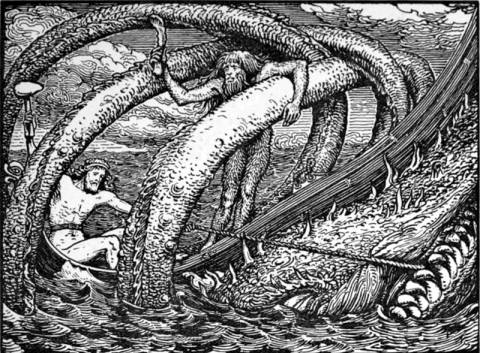
While not the main player in any story, Aegir does take part in several poems and stories both in the Prose-, and Poetic Edda.
Skáldskaparmál
Interestingly, part three in Snorri’s Prose Edda, the Skáldskaparmál, is styled as a dialogue between Bragi and Aegir. In this context, the background is set with Aegir being a man visiting the Aesir, and Bragi sharing stories and insight with him.
The Hymiskvida
One of two well-known tales featuring Aegir is the “Hymiskviða” from the Poetic Edda. Additionally, this poem recounts the story of Thor and Tyr, who embark on a quest to secure a giant kettle for Aegir to brew mead. Consequently, the kettle, large enough to accommodate the vast quantities of mead needed for a divine feast, is to be found in Tyr’s father’s house in Jotunheim.
The “Hymiskviða” is not only an exciting adventure story but also a demonstration of Aegir’s unique place in the pantheon, bridging the gap between giants and gods.
The Lokasenna
Another popular story featuring Aegir is the “Lokasenna,” a poem from the Poetic Edda. In this tale, Aegir hosts another feast for the gods in his magnificent underwater hall. However, the festivities take a dark turn when the trickster god Loki arrives, uninvited, and begins to insult and provoke the other gods. The poem is a series of flyting, a contest of insults and wits, between Loki and the gods.
Aegir, as the host of the feast, plays a critical role in setting the stage for the drama that unfolds. His hall serves as the battleground for Loki’s verbal onslaught, and his hospitality is tested by Loki killing one of his servants and the chaos that ensues. Ultimately, the “Lokasenna” provides a glimpse into the complex relationships between the gods as well as the role that Aegir plays in their lives. It is clear that Aegir’s hall is offering them a place of refuge and celebration, even in times of discord.
What is the significance of Aegir’s hall?
Aegir’s underwater hall is a Norse mythology marvel, nestled deep beneath the waves. Although the Eddas don’t explicitly describe the hall, we can infer its grandeur from the context. As the gods’ feast venue, it must be incredibly splendid and luxurious, reflecting Aegir’s status as a generous host.
The hall boasts golden walls and shimmering tapestries, providing a refuge for the gods. They gather here to share stories, laugh, and enjoy each other’s company. In this underwater sanctuary, they find respite from challenges faced above.
In addition to its beauty, Aegir’s hall holds significant symbolic importance in Norse mythology. Serving as a bridge between gods and giants, it represents the potential for harmony and unity among cosmic beings. Its ocean floor location emphasizes this theme, as water, earth, and air elements converge, symbolizing the natural world’s interconnectedness.
Furthermore, Aegir’s hall underscores his role as a connector of worlds, both terrestrial and divine. Through his hospitality and the feasts he hosts, Aegir fosters a sense of community and camaraderie among the gods, offering a space for shared experiences. As we explore his stories, Aegir’s hall continues to stand as a powerful symbol of unity and cooperation in the face of adversity.
How did the Vikings honor Aegir?
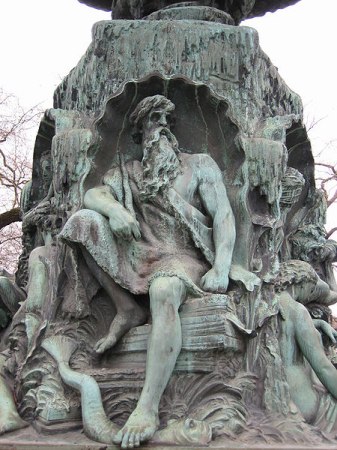
For the Vikings, a seafaring people, Aegir was a critical figure in their daily lives. Ruling the seas, his influence was felt in the tides, storms, and deep sea creatures. They believed Aegir’s favor or disfavor could determine their sea voyage success. As a result, they sought to appease him through various rituals and offerings, in hopes of securing his protection.
Aegir’s connection to the Vikings is further exemplified by the kenning, a poetic device in Old Norse poetry. In the “Skáldskaparmál”, Aegir is referred to as the “ale brewer of the gods” and the “husband of Ran.” This highlights his importance in the lives of both the gods and the Vikings who revered him.
Rituals and offerings to Aegir
To honor Aegir and seek his favor, Vikings would perform various rituals and make offerings before embarking on sea voyages. These offerings could include food, drink, or even valuable items such as gold or silver. By making these offerings, they demonstrated their respect for Aegir’s power and sought their safety on the often-treacherous seas.
In addition to making offerings, Vikings would invoke Aegir’s name in prayers and incantations. They asked for his protection and guidance as they navigated the ocean. These rituals served as a reminder of Aegir’s vital role in their lives. Moreover, it shows the delicate balance between humans and the powerful forces of nature.
Last thoughts about Aegir
Serving as the ruler of the sea and the gods’ host, Aegir expertly bridges the worlds of giants and gods. Consequently, he fosters unity and cooperation among various cosmic beings. His far-reaching influence on Vikings’ daily lives, sea voyages, and rituals further highlights his importance in Norse mythology.
Aegir, alongside his wife Ran and their family, reveals a complex, fascinating world. This world reflects nature’s interconnectedness and elemental power.
FAQs about Aegir
Aegir is a jötunn and a personification of the sea in Norse mythology. He is also known as Hlér or Gymir and often hosts grand feasts for the gods in his underwater hall.
Aegir is a jötunn, which means he is a giant in Norse mythology. However, he has a friendly relationship with the gods, often interacting with them, blurring the lines between god and giant.
Aegir’s wife is the sea goddess Ran, and together they rule over the ocean. They are the parents of the nine wave maidens, who personify various aspects of the ocean waves.
Aegir has control over the seas and storms, and he is known for his brewing skills and hospitality. He often hosts feasts for the gods, providing them with his famous ale.
There is some speculation that Aegir’s nine daughters, the wave maidens, may also be the nine mothers of Heimdall. However, this connection remains uncertain and open to interpretation.
Aegir appears in various Old Norse texts, including the Hymisviða and Lokasenna. In these stories, he plays a significant role in hosting feasts for the gods.
Vikings would often invoke Aegir’s protection during sea voyages and offer sacrifices to him. They believed that honoring Aegir would ensure safe passage and calm seas during their journeys.
Featured Image Credit: Nils Blommér, Public domain, via Wikimedia Commons

